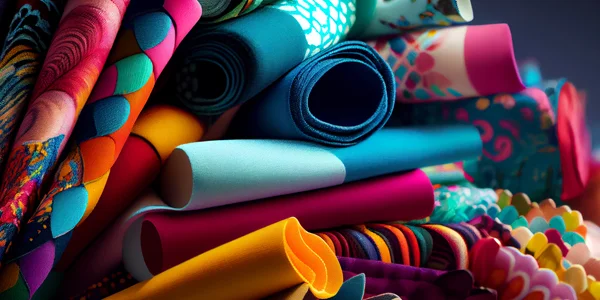Smart Fabrics: Runway To Reality Changing The Fashion, also known as smart textiles or e-textiles, refer to materials infused with technology that enables them to respond to environmental stimuli or perform specific functions beyond their traditional roles. These fabrics incorporate electronic components, such as sensors, actuators, or conductive threads, to enhance their capabilities. Smart fabrics can monitor physiological data, regulate temperature, change color or appearance, and even generate energy. They are designed to be integrated into clothing, home furnishings, or various other applications to provide functionalities that go beyond what conventional fabrics can offer.
History of Smart Fabrics
The development of smart fabrics traces back to various advancements in textile technology and electronics. While the concept of integrating technology into fabrics has gained traction in recent years, the roots of smart textiles can be found in earlier innovations:
Early Innovations:
- 1960s-1970s: Early research on conductive textiles and wearable technology began. Scientists explored the possibility of integrating conductive materials into fabrics.
1980s-1990s: The focus shifted toward creating textile-based sensors and conductive yarns.
Emergence of Wearable Technology:
- Late 1990s-2000s: The convergence of miniaturized electronics and textile engineering led to the emergence of wearable technology. This period saw the development of fabrics with embedded sensors for medical, military, and sports applications.
Advancements in Materials and Applications:
- 2000s-Present: Ongoing advancements in nanotechnology, conductive materials, and miniaturized electronics have expanded the capabilities of smart fabrics. Researchers and companies continue to explore applications in health monitoring, fitness, fashion, and even interactive textiles for artistic and entertainment purposes.
Commercialization and Integration:
- Recent Years: Smart fabrics have increasingly moved from research labs to commercial products. Companies have introduced clothing with built-in sensors for tracking biometric data, temperature-regulating fabrics, and interactive garments.
Diverse Applications:
- Present-Day: Smart fabrics find applications in various fields, including healthcare (for monitoring vital signs), sports (for performance tracking), fashion (for aesthetic and functional enhancements), military (for protective gear and communication), and home textiles (for temperature regulation and comfort).
As technology continues to advance and consumer demand grows, the development and integration of smart fabrics into everyday life are expected to expand, offering new functionalities and improvements in diverse sectors. Collaboration between textile engineers, material scientists, electronics experts, and designers remains crucial for further innovations in smart fabric technology.

Types of Smart Fabrics
Smart fabrics come in various forms, each designed to serve specific functions and applications.
Here are some types of smart fabrics:
- Conductive Fabrics: These fabrics are woven or coated with conductive materials like metallic threads or coatings, enabling them to conduct electricity. They are used in wearable technology, sensors, and for creating circuits in clothing.
- Shape Memory Fabrics: These fabrics have the ability to change shape or return to their original shape in response to stimuli like heat, electricity, or light. They’re used in applications like self-fitting garments or in medical devices.
- Phase Change Materials (PCMs): PCMs are integrated into fabrics to regulate temperature. They can absorb, store, and release heat to maintain a stable microclimate, providing comfort in clothing and bedding.
- Photochromic Fabrics: These fabrics change color when exposed to light or UV radiation. They’re used in fashion, outdoor gear, and decorative textiles.
- Thermochromic Fabrics: Similar to photochromic fabrics, these change color in response to temperature variations. They’re employed in clothing, textiles for safety applications, and as indicators for temperature changes.
- Biometric Monitoring Fabrics: Embedded sensors in textiles can monitor physiological data such as heart rate, temperature, or sweat levels. These are utilized in fitness wearables, medical monitoring garments, and sports apparel.
- Energy Harvesting Fabrics: These fabrics generate and store energy from sources like movement or light. They’re used to power small electronic devices or to charge batteries in wearable tech.
- Antibacterial Fabrics: Infused with antibacterial agents, these fabrics inhibit the growth of bacteria, making them suitable for medical textiles, sportswear, and everyday clothing.
- Water-Repellent or Waterproof Fabrics: Treated with hydrophobic coatings or integrated with nanotechnology, these fabrics repel water and are used in outdoor gear, rainwear, and protective clothing.
- Electroluminescent Fabrics: These fabrics emit light when an electric current passes through them. They’re utilized in fashion, signage, and decorative textiles.
- Sensory-Embedded Fabrics: Incorporating sensors like pressure sensors, proximity sensors, or touch-sensitive materials, these fabrics enable interaction or response to external stimuli.
Each type of smart fabric serves a unique purpose, and ongoing research and technological advancements continue to expand the possibilities for their application across various industries.
Facts of Smart Fabrics
Absolutely! Here are some interesting facts about smart fabrics:
- Multi-Functionality: Smart fabrics can combine multiple functionalities into one material. For example, a single fabric might integrate sensors for monitoring biometric data, while also having energy-harvesting capabilities.
- Customization and Personalization: They offer the potential for customization, allowing users to personalize their experiences. For instance, temperature-regulating fabrics can adjust to individual comfort levels.
- Health Monitoring: Smart fabrics enable continuous health monitoring by integrating sensors that track vital signs such as heart rate, body temperature, and even hydration levels.
- Environmental Adaptability: Some smart fabrics respond to environmental changes. For instance, thermochromic fabrics change color in response to temperature fluctuations.
- Improving Safety: They have applications in enhancing safety, like embedding visibility-enhancing materials for high-visibility clothing or creating fabrics that detect and alert in hazardous situations.
- Integration with Fashion: Smart fabrics are making their way into fashion, enabling designers to create interactive and technologically enhanced clothing that blurs the line between fashion and function.
- Sustainability: Advancements are being made to create sustainable smart fabrics, incorporating eco-friendly materials and manufacturing processes.
- Military and Aerospace Applications: They are used in military and aerospace industries for protective gear, communication systems, and even in developing adaptive and responsive fabrics for space exploration.
- Challenges in Washing and Durability: Maintaining functionality after washing remains a challenge for many smart fabrics. Researchers are working on solutions to improve durability and washability without compromising functionalities.
- Advancements in Nanotechnology: Nanotechnology plays a crucial role in enhancing the capabilities of smart fabrics, allowing for the creation of smaller and more efficient components integrated into textiles.
- Market Growth: The market for smart fabrics continues to expand, driven by increased demand in various industries such as healthcare, fitness, fashion, and automotive sectors.
These fascinating aspects showcase the versatility and potential of smart fabrics, continually evolving to meet diverse needs and push the boundaries of what textiles can achieve.
Benefits of Smart Fabrics
Smart fabrics offer a range of benefits across various industries and applications.
Here are some of their key advantages:
- Enhanced Functionality: They provide functionalities beyond traditional fabrics, such as monitoring health metrics, regulating temperature, or integrating electronic components for communication.
- Health Monitoring and Wellness: Smart fabrics equipped with sensors can monitor vital signs, allowing for continuous health tracking without the need for external devices. This facilitates proactive health management and early detection of health issues.
- Comfort and Performance: Fabrics with moisture-wicking properties, temperature regulation, or shape adaptability enhance comfort in various environments. Performance-enhancing smart textiles are also used in sports and athletics.
- Safety and Protection: Smart fabrics are utilized in protective clothing for firefighters, military personnel, and workers in hazardous environments. They can provide protection against fire, chemicals, and physical hazards while incorporating visibility-enhancing features.
- Energy Efficiency: Some smart fabrics can generate and store energy from sources like movement or light, contributing to the development of self-powered wearable devices and reducing reliance on external power sources.
- Environmental Adaptability: Fabrics that respond to changes in the environment, such as temperature-regulating materials or self-adjusting clothing, offer adaptability and comfort in different conditions.
- Aesthetic and Design Innovation: They enable designers to create technologically advanced and aesthetically pleasing clothing, integrating electronics seamlessly into fashion and textiles.
- Improved Communication: Smart fabrics can incorporate conductive threads or sensors for communication purposes, facilitating data transmission or interaction in various applications.
- Sustainability and Efficiency: Advancements in materials and manufacturing processes aim to create eco-friendly smart fabrics, contributing to sustainability efforts in the textile industry.
- Diverse Applications: The versatility of smart fabrics allows for applications in healthcare, sports and fitness, fashion, automotive, aerospace, and even in architecture and interior design.
These benefits highlight the potential of smart fabrics to revolutionize numerous industries, offering solutions that improve comfort, safety, health monitoring, and overall quality of life.

What is the future of smart fabrics?
The future of smart fabrics is incredibly promising, with ongoing research and technological advancements poised to revolutionize multiple industries.
Here’s a glimpse of what lies ahead:
- Integration and Miniaturization: Continued advancements in nanotechnology and miniaturization will lead to smaller, more efficient, and less obtrusive components within smart fabrics, enhancing their functionality without compromising comfort.
- Enhanced Connectivity: Smart fabrics will become more interconnected, allowing seamless communication between devices and the Internet of Things (IoT). This connectivity will enable real-time data collection, analysis, and response, fostering smarter and more responsive textiles.
- Health and Wellness Applications: The future will see smart fabrics play an even more significant role in healthcare, with advancements in biometric monitoring, disease detection, and personalized health management. These fabrics could assist in remote patient monitoring, early disease detection, and proactive health interventions.
- Adaptive and Responsive Textiles: Fabrics that adapt to environmental changes, such as temperature, moisture, or light, will become more sophisticated. They’ll offer enhanced comfort and efficiency by dynamically adjusting to the wearer’s needs.
- Energy Harvesting and Self-Powered Devices: Advancements in energy-harvesting technologies within fabrics will enable the creation of self-powered wearable devices, reducing reliance on external power sources and extending device usability.
- Wearable Computing and Augmented Reality: Smart fabrics will play a crucial role in the development of wearable computing, integrating sensors, displays, and computing elements into clothing for augmented reality experiences, enhanced communication, and data visualization.
- Fashion and Design Innovation: Designers will continue to explore the integration of technology into fashion, creating aesthetically pleasing garments that offer both style and functionality. Smart fabrics will blur the lines between fashion, technology, and performance.
- Sustainability Focus: Research and development will prioritize sustainable materials and manufacturing processes, contributing to eco-friendly smart fabrics that reduce environmental impact and promote circularity in the textile industry.
- Customization and Personalization: Advancements in manufacturing techniques will enable greater customization of smart fabrics, allowing for tailored solutions that meet individual needs and preferences.
- Expanded Applications: Smart fabrics will find applications beyond traditional sectors, including in architecture, automotive interiors, and smart home textiles, transforming various aspects of daily life.
As research, development, and consumer demand continue to drive innovation, the future of smart fabrics holds immense potential to enhance comfort, improve health outcomes, boost efficiency, and transform the way we interact with textiles in our everyday lives.
Are there privacy concerns with smart fabrics?
Absolutely, privacy concerns are a significant consideration when it comes to the integration of technology into textiles. Smart fabrics, particularly those embedded with sensors or connected to networks,
Raise several privacy-related issues:
- Data Collection and Security: Smart fabrics often collect sensitive data, such as biometric information or personal activity patterns. There’s a risk of this data being intercepted, hacked, or accessed without consent, leading to privacy breaches.
- Unauthorized Access: If the communication channels or sensors within smart fabrics aren’t adequately secured, they can be vulnerable to unauthorized access. This could result in the exposure of personal information or even remote control of devices embedded in the fabric.
- Tracking and Profiling: Continuous monitoring through smart fabrics could potentially lead to tracking individuals’ movements, habits, and health data, raising concerns about surveillance and the creation of detailed profiles without consent.
- Lack of Consent and Transparency: Users might not always be aware that the fabric they’re wearing is collecting data or transmitting information. Lack of transparency about data collection practices can lead to a breach of trust and privacy concerns.
- Data Sharing and Third-Party Access: Smart fabric companies might share collected data with third parties for various purposes, including research, marketing, or product development. If not handled appropriately, this sharing can compromise user privacy.
- Retention and Usage of Data: Questions about how long collected data is stored, how it’s used, and whether it’s anonymized or pseudonymized are crucial. Prolonged storage or misuse of data can pose significant privacy risks.
To mitigate these concerns, manufacturers and developers must prioritize:
- Security Measures: Implement robust encryption, authentication protocols, and secure data transmission methods to safeguard collected information.
- User Consent and Transparency: Clearly inform users about data collection practices, enabling informed consent and providing opt-out options.
- Anonymization and Limited Data Access: Minimize personally identifiable information collected and limit access to sensitive data to authorized entities only.
- Regulatory Compliance: Adhere to privacy regulations and standards to ensure that smart fabric technologies comply with legal frameworks governing data protection.
As smart fabric technology evolves, addressing and actively managing these privacy concerns will be crucial to building trust among users and ensuring the responsible and ethical use of these innovative textiles.





